'Selwood': an early Davenport house and its residents

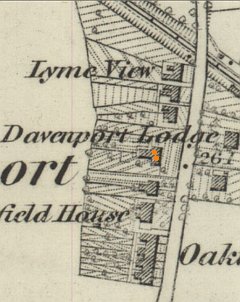
Above: Selwood and Rowan Cottage, shown above in orange, 1870s. Oakfield Road at that time was just an access track to the farmland behind. The two buildings to the south (140-144) no longer exist, replaced c. 1970 by the 'Kennerley Lodge' flats.
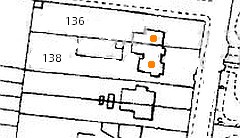
1910: Selwood enlarged and a building, described as a 'washhouse, tool-house and summer-house', built in the grounds.
Sales
To be sold by auction, by Messrs Hopwood & son, at the Warren Bulkeley Arms Hotel, Stockport, on Friday the 16th day of December, 1904, at seven o'clock in the evening prompt, subject to the general conditions of sale of the Stockport Incorporated Law Society and to special conditions to be then produced:
Lot 1. ALL that VILLA RESIDENCE, situated at Bramhall Lane, and known by the name of Selwood. This property is an exceptionally attractive residence. Bramhall Lane, on which it is situated, is well timbered, and is by far the most picturesque road out of Stockport. It is one minute from Davenport railway station and five minutes from the Stockport and Hazel Grove tramway route. The site contains 1,513 yards or thereabouts. It is freehold, and will be sold subject to a yearly chief rent of £10. It contains a dining-room, 19ft.3in by 12ft 3in., exclusive of bay; drawing-room, 14ft.3in by 13ft. exclusive of two large bays; morning-room 15ft.6in. by 12ft. 6in. exclusive of bay; five good bedrooms, kitchen, scullery, bathroom and w.c., also lavatories on the ground and first floors. The cellars are dry and roomy, and there is a washhouse, tool-house and summer-house outside. The garden is well-stocked with shrubs, fruit-trees, and plants, and is one of the best and most productive in the neighbourhood. There is a good heating apparatus on the premises.
Lot 2. All that VILLA RESIDENCE situate at Bramhall Lane, known by the name of Rowan Cottage, and adjoins lot 1. The site contains 1,210 yards or thereabouts. It is freehold, and will be sold subject to a yearly chief rent of £5. It contains and entrance lobby, dining-room, drawing-room, kitchen, three bedrooms, bathroom and w.c. The cellars are dry and roomy, and their is an outhouse and convenience, and the garden is well stocked. It is now in the occupation of Mr. Fred Broadhurst; his tenancy commenced in June, 1904 at a yearly rental of £26.
Both are outside the old borough of Stockport, and consequently the advantage of the preferential rate ... for further particulars apply to the Auctioneers, 3 Warren Street, Stockport; to Mr Peter Peirce, St. Petersgate, Stockport; or to OLIVER COPPOCK, solicitor, Stockport.
The Manchester Guardian, November 29, 1904, p.3
Selwood, Davenport. Hopwood and Son have been favoured with instructions from the Exors. of the late Alderman Harrison, J.P., to SELL BY AUCTION, on Wednesday 15th February 1905, the Choice and Valuable HOUSEHOLD APPOINTMENTS, comprising mahogany hat and umbrella stand, with marble slab; mahogany hall chair, barometer in mahogany case, marble clock, choice ebonised drawing-room suite, in Chippendale taste, consisting of single and occasional chairs, upholstered in silk tapestry; very handsome display cabinet, with bevel plates, brackets and display shelves; overmantel, with bevel plates and brackets, occasional table, all en suite and nearly new; excellent pianoforte, in walnutwood case, by Kirkman, sweet tone, full compass, nearly new; carved pollard oak dining-room suite, by Turner, beautifully made, consisting of six single and two easy chairs, upholstered in bite-figured plush; massive pollar oak sideboard, with richly carved panel fronts, plate-glass centre, and cellarette; carved pollard oak overmantel, pollard oak telescope dining table, on massive turned supports; pollard oak pedestal coal vase, all en suite; massive brass and iron curb and dogs, inlaid walnut wood chiffonnier, with plate-class mirror and marble slab; walnutwood sofa, upholstered in rep, Walnutwood pedestal coal vase, mahogany dining-room suite, oak chiming timepiece, with oxidised dial; mahogany telescope dining table, with two loose leaves; very handsome all-brass bedstead, walnutwood dressing-table, with swing mirror; walnutwood washstand, with marble slab; walnutwood centre table, walnutwood whatnot, deed chest, bamboo invalid carrying chair, commode, semi-billiard table, kitchen dresser, hardwood top; quantity of kitchen utensils, carpets, oilcloth, star rods, crockery, glassware, electro plate, cutlet, &c., Victoria bath chair, by Dillon, Bath, rubber types, mounted on steel springs, coach painted and fitted with self-guiding front wheel, carriage upholstered, nearly new and of the very best make. On view Tuesday 14th February, from eleven till four. Sale to commence at eleven o'clock.- For catalogues and further particulars apply to the Auctioneers, 3, Warren-street, Stockport. Telephone, 123.
The Manchester Guardian,
February 11, 1905, p.16
The works
The works buildings were built on a small part of a 119-acre area on the east due of Wellington Road owned in 1850 by Sir Ralph Pendlebury, one of Stockport's wealthy self-made mill-owners, best known for the orphanage 'Pendlebury Hall' built with money from his bequest, which overlooks the town from Heaton Norris. He died in 1861.The Land Registy records that In 1883, William Harrison bought the land on which the works extension alongside Marriott Street stands (and possibly the buildings as well?) from Charles Carr, probably the Stockport-born son of a Cotton and Silk manufacturer, John Carr, whose family home was Higher Bank House (now called Hillbrook) in Bramhall. Around that time the Carr family retired and re-located to Southport.
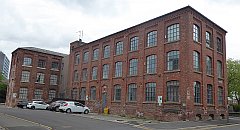
Adjacent to the works, and long demolished, were long single-storey sheds known as the 'wet-end' where the animal skins (badger, later mostly rabbit) were processed to produce the felt material.
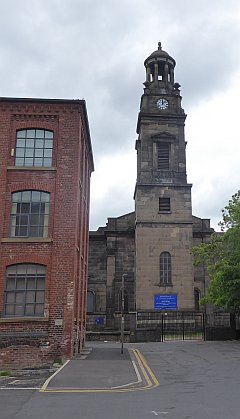
In 1920 the works, renamed Marriott Street Mills, was occupied by Robert Bailey & Son Ltd, manufacturers of surgical dressings. Later, Baileys opened an additional site in Dysart Street, Great Moor, which eventually became their main base. They still operate from there in 2020.
More recently the Manchester Antique Company operated from the Marriott Street buildings as a warehouse and auction room, dubbed 'Mac Court'. In the twenty-first century, from about 2009, the two main blocks have been converted to apartments, with addition of new buildings added on the original factory site. The M.A.C. relocated to a new building in Sale.

The old sign omits the 'apostrophe-s'.
On-line Sources
British Newspaper Archive; Guardian online (courtesy of Manchester Libraries); Cheshire Tithe Maps; Ancestry.co.uk; Old-maps.co.uk; National Library of Scotland maps; The UK Land Registry; Stockport Library image archive; also Street directories available on our site.Special thanks to Allan Russell for the History of Stockport in 100 Halls website.
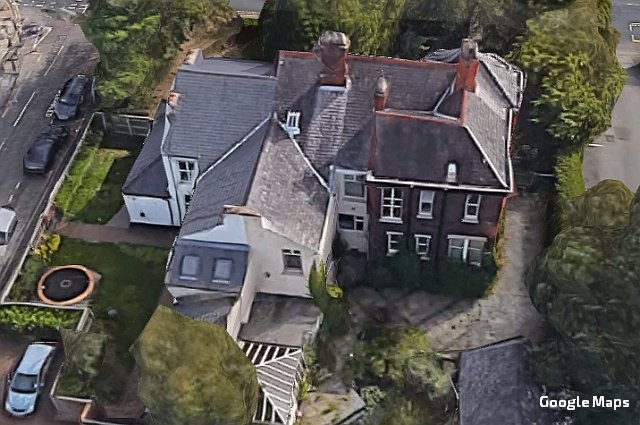
'Selwood', 138 Bramhall Lane, which was under renovation as this was originally written (May 2020) which by 2022 was occupied after delays no doubt relate to the 'pandemic' , is on the right of the Google image above, viewed from the rear to avoid trees. It dates back to the days when Davenport was little more than a hamlet, clustered around (and named after) the little-used railway station that Colonel Davenport of Bramall Hall had insisted on being provided in return for the sale of land. The map in the left column shows the entire settlement, apart from the large house 'Bramall Mount' to the north on the other side of the railway.
It has a somewhat unusual feature: another house, no. 136 (the white-rendered part in the image), at one time called 'Rowan Cottage' in a completely different architectural style, is intimately attached to it, making it a 'semi-detached' to the estate agent. The pair stand at the south-west corner of Oakfield Road, which in the 1860s was no more than an track leading to the fields of Yew Tree Farm behind; the pine tree in the garden of no. 136 is an iconic feature of present-day Davenport.
According to the Land Registry, the two houses were built on a plot of land (part of a field known as Simms Croft Pasture) leased by William Davenport Davenport to a Sarah Glossop in 1863. For some reason, the land allocated to Mile End Farm, the farmhouse of which stood by the main Stockport - Buxton road near the present entrance to the Davenport Park estate, extended across Bramhall Lane. To the west of the plot was a field of Yew Tree Farm, and that boundary determined the shape of the building plots. When built, the two houses 136 and 138 were much the same size in a standard semi-detached style; both have been much-altered over time.
Exploring the early years of the two houses is difficult because in 1871 and 1881 the census-taker did not identify individual houses, which at that time were not numbered, just writing 'Davenport' against all of them. However, the Land Registry record implies that the land was purchased as an investment by, or for, Sarah Glossop, and that the first resident of no. 136 was Charles Chorlton, a retired salesman born around 1800 in Ardwick, Manchester, who appears in the 1871 census with 55-year-old Anne Sidebotham, born in Stockport, as housekeeper. No. 138 (future 'Selwood') seems to have been 'unoccupied' in 1871; it was probably also owned by Charles Chorlton.
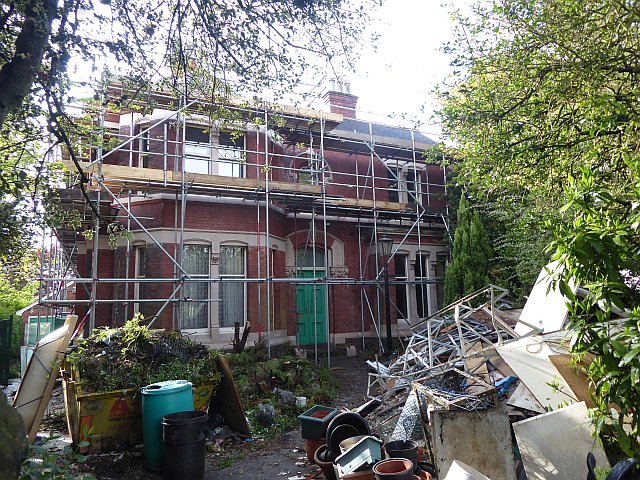
Renovation in progress at no. 138, 2020.
William Harrison, Hatter
The name 'Selwood' was attached to the house sometime around 1883 when William Harrison moved in to the house (later numbered 138) with his family. He was born in 1835, and gave his birthplace as Frome, Somerset. Selwood is a village close to that town, which over time has become a suburb. In 1851, still in the Frome area, he was working as a boot and shoe maker, By 1861, he had moved to Stockport, and was describing himself as a 'hatter, master employing 7 men and 2 boys' and already had a Stockport-born wife, Harriet Harrison, aged 25, who worked as hat trimmer. They lived at 21 (later 23) Union Street, Stockport, and William had formed a partnership with another hatter, James Stafford of 49 Union Street. Stafford was born in 1825, and in 1851 he is listed living with his father James, a milk seller, at 19 Union Street.
A workshop in a Union Street back yard by 1851 grew over the years into a large purposed-built factory complex, named St Thomas's Works. Harrison had arrived in Stockport at an auspicious time. Historian Peter Arrowsmith in his book Stockport: a History writes:
In 1860 the number of people living in the town who worked in the [hat] industry is said to have been 473. Thirty years later there were estimated to be ten times that number. The growth was a consequence of a revival in the popularity of felt hats, after a slump in the 1840s when silk hats became the fashion, and of changing methods of production which enabled manufacturers to meet this demand.Harrison and Stafford rode the wave of the demand; one has to be impressed that Harrison was able to learn a new trade in such a short period and eventually join the hatting elite of the town, to become a Justice of the Peace and an Alderman.
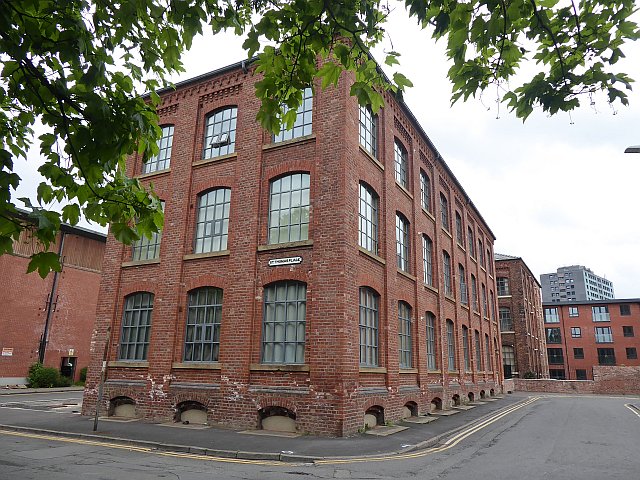
The St Thomas's Works in 2020, now apartments.
As the firm grew, the Harrisons moved to other houses within easy reach of the factory. They were at 56 Wellington Road South by 1871, and by 1881, 'Fernleigh', 13 Marsland Street, by which time they had sons Joseph Bancroft Harrison (17), Albert Edward Harrison (15) and William Isaac Harrison (14) at home, and a servant. (This was not Marsland Street in Portwood, but the street which soon afterwards was renamed St Thomas's Place, leading from Wellington Road to the Church.) The house, which would have been very close to the factory, has proved difficult to identify, as maps show houses ending at no.9. The 1891 census lists two houses 'off St Thomas's Place', named as 'Grundy Place' in 1901 although not named on any map. It is likely they were eventually demolished during a factory extension.
By 1891 Stafford had retired and the firm had become William Harrison & Sons. The family were settled in 'Selwood': William, hat manufacturer, with his sons Albert Edward (25) and William (24), both born in Stockport and also hat manufacturers, partners in the firm. (Joseph had left home, but was also a partner.) On hand were two servants: housekeeper Lydia Harrison and general servant Sarah Marsland. Harriet was not present, but William is not listed as widowed; we can't establish definitely what happened to her.
It's not surprising that the Harrisons decided to move to Davenport, as by 1891, other hat manufacturers, including the the Christys and members of the Lees, Ward and Battersby families, had set up home there. We believe that it was the Harrisons who commissioned the house extensions; they also owned 'Rowan Cottage' and seemingly altered that too, although not so drastically.
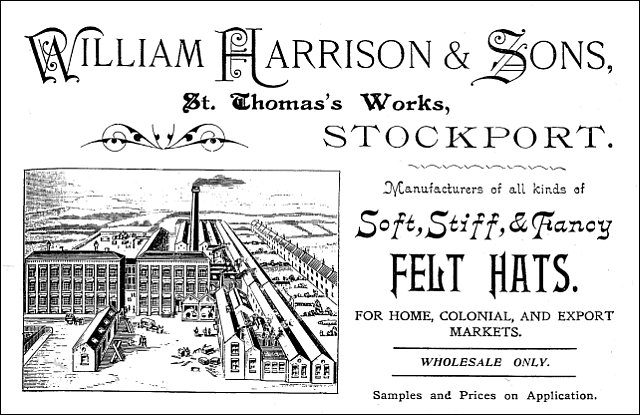
Advert from 1902. The artist has
exaggerated the perspective.
William Harrison & Sons manufactured felt hats for the wholesale market, and did not become famous names like Battersby and Christy whose hats were sold under their own name. Penny McKnight, in her book Stockport Hatting, quotes the Hatters' Gazette: 'the name of Harrison's [is] accepted as a guarantee of substantial quality, with their products finding their way in large consignments to many parts of the globe.'
The 1901 census found William and William Isaac Harrison the only family members present at Selwood, along with four servants: housekeeper Lydia Harrison, two general servants Margaret Oswald and Mary Hill, and a nurse, Anna Hyslop.
William Harrison (senior) died in 1904, by which date he was President of the Hat Manufacturers Association for Stockport and District. The items in the house inventory after his death includied a bath chair and an invalid carrying chair, suggest he had not been well for some time. In his will he left an estate worth £24,404 net. He bequeathed £100 to the Stockport Sick Poor Nursing Association, and £250 to housekeeper Lydia Harrison. He directed that £13,500, including his interest in the firm, should be held in trust for his son Albert Edward, and the residue to his two sons and partners Joseph Bancroft and William Isaac. It would seem that Albert suffered some kind of disability.
William Isaac Harrison, who had married Bertha Ainscow in 1904, died in 1908, aged 41. He had cycled from Stockport to Whaley Bridge, then left his bike in the village and set off on foot, to to see a friend who worked on the estate of Colonel Jodrell of Taxal Lodge, or attend a funeral, depending on which newspaper you read. He never arrived, and his body was later found in Toddbrook reservoir; the reservoir dam would have been on his walking route. It was suggested at the inquest that he slipped and fell into the water, and was unable to get out. His widow Bertha, and young daughter Annie Harrison, are recorded in the 1911 Census 'living on own means' with a live-in servant at 166 Bramhall Lane, not far from her brother-in-law Joseph.
The firm carried on for a while under Joseph Bancroft Harrison who had his own Davenport villa - 'Glenariff' , no. 295 Bramhall Lane, semi-detached partner of no. 297 'Rothberg'. (The building was demolished to create the 'Southlands' apartments completed in 2006.) In 1891 Joseph had married schoolmistress Emma Marshall, a daughter of Stockport-based master builder John Marshall. They had five children, but the 1911 census, where he lists himself as 'hat manufacturer', reveals that two of them had died, leaving twins Margaret and Alice and their sister Constance. Like his father he served as a magistrate, He sold Selwood and Rowan Cottage at auction soon after his father's death, and also auctioned the 'household appointments' of Selwood (see left column).
After 1908, the hatting business seems to have faltered, and by 1914 it was no longer listed in directories.
Later Residents
'Selwood' had a number of short-term residents in the years immediately after the sale. The house name was not changed, which suggests that they were simply tenants. The 1911 census lists John Smith, aged 47, commercial traveller (chocolate), born in Pontefract, Yorkshire, their five Children and a 'mother's help.' A 1914 directory mentions a 'Mrs Fletcher'. A 1918 newspaper notice marks the birth of a baby to Ethel Mary Ferns, the wife of John Astley Killer Ferns (1879-1960) of 'Selwood'. He was a Stockport-born solicitor, son of Alfred Ernest Ferns, also a solicitor and coroner.
By 1923 Harry Holt (born 1873) a cotton goods merchant, had appeared on the Selwood scene, and stayed for much longer. The 1939 register lists him with his wife Ada Holt (also born 1873) and son Alan L. Holt, born 1918, a cotton goods salesman who served in World War II as an A.R.P. ambulance driver. Ada died, aged 86, in 1960; Harry remained at Selwood, joined by Alice Drabble, his daughter, whose husband George Drabble had died in 1957. Harry Holt died in 1966, aged 92.
The residents immediately before the sale in 2020 had been there since 1976.
No. 136 'Rowan Cottage'
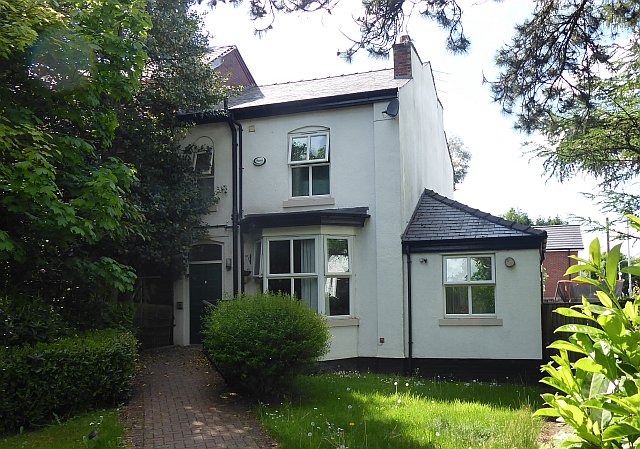
No.136 in 2002.
'Rowan Cottage', the partner of Selwood has had a varied career, not all of which we can disentangle. Charles Chorlton, recorded in 1871, moved in by 1881. In 1901 it was empty. Fred Broadhurst, mentioned as tenant in the auction advertisment, was a carpenter and joiner, who later lived with his wife Maud Platt Broadhurst at 50 Kennerley Road.
Charles Edwin Chamberlain, born in 1878 in Shepton Mallet, Somerset, is recorded on the Land Registry as purchasing the house from Joseph Bancroft Harrison in 1914, ten years after the auction. He is listed in the 1939 register as resident at No. 136 with his wife Alice Chamberlain, born 1878. Earlier records list him as the owner of a house painting and decorating business, living at an address at 223 Bramhall Lane with Alice and their son Albert Charles Chamberlain. It's likely that they moved to No.136 when no.223, like its neighbours, was turned into a shop, which at the time of writing is the northern part of 'Bargain Booze'.
The next record we have is from 1965, when a Leonard W. Whalley was sole resident listed on the Electoral Register. Later, the house was converted to the 'Happy Days' nursery, which according to its current website at the time of writing has been established for over 40 years. Around 2000 the nursery relocated to a purpose-built building in Heath Road on the site of the former 'Davenport Club' , and in 2020 it is part of the 'Kids' Planet' chain. In 2004 no. 136 was purchased by the Equity Housing Group for £185,000, and converted to social accommodation for five residents. Two new small houses, 1 and 3 Oakfield Road, were built on what had been the garden, despite comments by locals that residents would suffer noise and disruption from the businesses opposite, which has proved to be the case.
At some time, ground at the far end of the garden was sold, and an entry gate installed in Oakfield Road. In 2020 there are remains of a structure, possibly a garage. In 2015 planning permission was granted for a 'single-storey dwelling' on part of the garden of no.138, using this gateway as access, but as of May 2023 no work has been done.
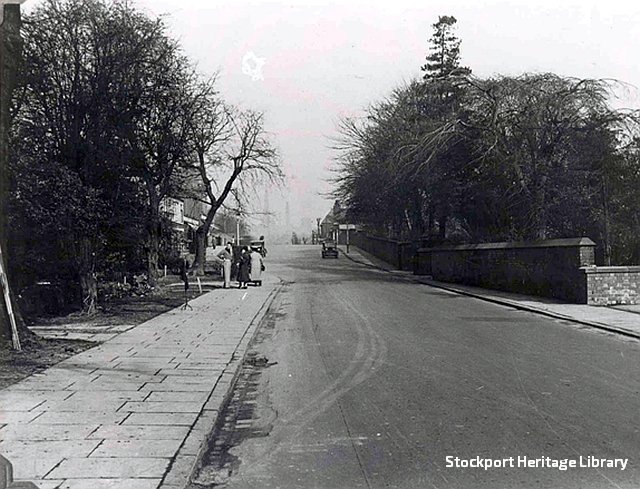
Th1s image dated 1937 was taken during the widening of Bramhall Lane. The pavement is about to be moved back to match the line of the shops opposite the station, seen in the distance. Strips of the front gardens of 'Selwood' and the other houses of the original settlement were bought by the Council for the purpose.
Printed Sources
Penny McKnight, Stockport Hatting. Stockport: Stockport Borough Council, 2000.Peter Arrowsmith: Stockport, a History. Stockport: Stockport Borough Council, 1997.
Written by Charlie Hulme, May 2020. Updated July 2023.
Comments always welcome at charlie@davenportstation.org.uk